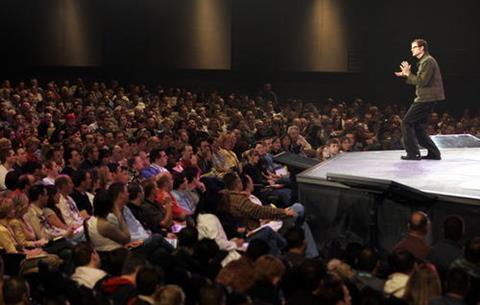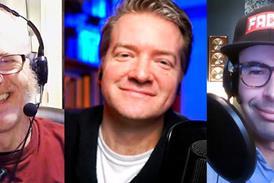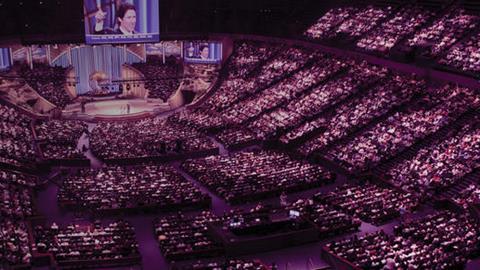Our kids still remember the day we visited Saddleback in California. There was dancing, drama and singing. There were video games, themed play parks and an indoor aquarium and reptile display. They even came away with branded water bottles. But Saddleback isn’t a theme park, it’s a church.
Saddleback is one of the USA’s 1,600 megachurches – defined as a church with more than 2,000 people in weekly attendance. While these large churches are still outnumbered by smaller churches in the country, their influence is undeniable. Over half of all the people who go to church in the USA attend a megachurch.
But megachurches have plenty of critics. The complaints frequently invoke the old adage of being ‘a mile wide and an inch deep’. They are accused of pandering to a consumerist mentality. And how exactly do you build meaningful community in a church that is literally made up of thousands of people?
As the husband to Lucy, a minister of a (more modestly sized) church in Surrey, I wanted to find out what US megachurches were really made of and what lessons we might learn in the UK. So, on two visits over several years, and with our four children in tow, we went on a great American adventure. Our stop-offs were at six very different megachurches that also had a lot in common.
1. Lakewood church, Houston

Meeting in a converted basketball stadium (pictured above), Lakewood Church in Texas lays claim to being America’s largest church with up to 50,000 attendees across its multiple services. The 16,000-seat sanctuary serves as a cavernous studio for pastor Joel Osteen’s incredibly popular TV ministry, with cameras on large boom arms swinging back and forth and a production quality to the staging, lighting and sound that would rival The X Factor.
2. Mars hill bible church, Grand rapids

When my megachurch marathon began back in 2009 I journeyed up to the northern reaches of Michigan to visit Mars Hill Bible Church. They had a celebrity pastor of their own at the time – Rob Bell. The church was very large (around 10,000) but the style and theology couldn’t have been more different to Lakewood.
While Osteen delivered a feel-good motivational talk (my wife likened it to spiritual fast food), Bell preached a meaty and creative theological sermon. Osteen’s made-for-the-cameras theatricality stood in stark contrast to the informal hipster vibe exuding from the stage at Mars Hill Bible Church.
Get access to exclusive bonus content & updates: register & sign up to the Premier Unbelievable? newsletter!
3. Brooklyn tabernacle, New York

The next journey took us from the East to West Coast of the USA, starting in New York. There we visited Brooklyn Tabernacle, led by pastor Jim Cymbala since the 1970s. Multicultural, urban and meeting in a beautifully renovated 3,000 seat theatre, the church is renowned for its gospel choir that performs all over the world. We were given front row seats and the experience was heavenly. Worship can feel like a spectator sport in some megachurches; not so here. The congregation sang their hearts out, led by the 200 strong voices on stage throughout. Cymbala’s ministry at the church has attracted a diverse congregation. Their Tuesday night prayer meeting acts as the engine of their ministry to one of New York’s toughest neighbourhoods. It’s part of a wider story of an unlikely revival in a traditionally sceptical city.
4. Hillsong, NYC New York

I also dropped in for an evening service at one of the city’s newest churches. Hillsong NYC, begun in 2010, was the church that made me feel old. Everybody in the congregation seemed to be under 30. Meeting at a rented theatre on Times Square, the service I attended felt more like being in a nightclub than a church, with the congregation bouncing around to electro-synth worship music, led from the front by an entourage of good-looking musicians and singers.
The church is led by a tattooed pastor who is a close friend of Justin Bieber. In fact, Pastor Carl Lentz is credited with helping to put the pop star back in touch with his Christian faith.
5. Calvary chapel, Costa Mesa Los Angeles

Travelling to the West coast of California, we visited the final two churches on our itinerary. Megachurches are a relatively recent phenomenon and Calvary Chapel Costa Mesa was one of the first in the 1970s. Only a stone’s throw from LA’s surf city Huntington Beach, the church grew rapidly under the ministry of its charismatic pastor Chuck Smith in the late 60s.
It was at the epicentre of the Jesus People movement, which saw thousands of hippies, surfers and beatniks come to Christ as they swapped psychedelic drugs and rock and roll for the Holy Spirit and a new wave of folk-rock worship music. Many more Calvary Chapels were consequently birthed across the USA, led by the converts of the 60s and 70s. Even with their explosive growth now a generation past, the Costa Mesa flagship church still draws significant numbers under the ministry of Brian Brodersen.
Get access to exclusive bonus content & updates: register & sign up to the Premier Unbelievable? newsletter!
6. Saddleback church, Orange County

Finally we visited Saddleback Church, led by the irrepressibly energetic Rick Warren. The church was founded in his front room in 1980 but now draws up to 25,000 people to its weekend services, making it the eleventh largest church in the country.
Basking in the year-round California sun, this multi-acre campus in Orange County felt like a holiday resort. There were beautifully landscaped grounds and water features. Deckchair seating on the shaded veranda outside the Worship Centre allowed visitors to watch on large outdoor screens. There were coffee and ice cream outlets, a restaurant, multiple worship venues and, of course, the out-of-this-world children’s facilities.
The leadership factor
So what connects these very different, very large churches?
One obvious link is that they are all led (or were founded) by exceptionally talented leaders. Joel Osteen and Rob Bell may have been poles apart in terms of their theology, but they are both brilliant communicators to their respective audiences. Likewise, Rick Warren, Jim Cymbala, Carl Lentz and the late Chuck Smith all had dynamic personalities that formed a natural centre of gravity for their churches to develop around.
Of course the Holy Spirit is involved. But the Spirit works through people, and those who build large churches tend to be driven, pioneering leaders with high aspirations.
Often the difficultly comes in managing leadership transitions. Large churches built on the ministry of unique individuals often struggle when the leader passes away or moves on. And more than one megachurch has imploded after a leader fell from grace – Mark Driscoll and Mars Hill Church in Seattle is the most recent famous example.
Seeker sensitive churches
The ‘seeker sensitive’ model of church growth has been almost universally adopted by growing churches today. Intentionally welcoming newcomers, an informal style and practical teaching are hallmarks of the approach. But while the seeker sensitive pattern was perfected by churches like Saddleback and Willow Creek, Chuck Smith at Calvary Chapel was the person who started it.
When the pastor’s preaching started to draw hippies into his hitherto traditional church, he saw the opportunity of embracing a new generation of believers by accommodating their musical preferences, long hair and hippy attire. Chuck spoke their language, while keeping to the gospel message.
Joycelyn Bell, a member of the church who joined before the hippy revival, tells how her brother once put a sign up saying “no bare feet allowed”. Pastor Chuck promptly took it down again. What may seem obvious in modern church circles about welcome, and musical and cultural engagement, was revolutionary when Chuck Smith first did it in the 1960s.
Today an informal approach is the norm at most megachurches. At Saddleback, Rick Warren usually preaches in a Hawaiian shirt and shorts. The pastor is known globally for his bestselling book The Purpose Driven Life (Zondervan). But its precursor was The Purpose Driven Church (Zondervan), the defining handbook of how to build a church on the principles employed at Saddleback.
The laid-back, Californian vibe at Saddleback is only made possible by an army of pastors, staff and volunteers engaged in intentionally reaching, welcoming and engaging new attendees. It’s an approach which has seen them baptise a record 50,000 people.
Megachurch Saddleback style
For us, the welcome began from the moment we drove into the church’s capacious car park. Smiling volunteers in branded T-shirts waved us in the right direction, and when we dropped our children for their activities (you know, with the indoor aquarium), they were registered on an iPad, and a barcode receipt ensured that we would be safely reunited with them after the service.
We megachurches don’t do discipleship well
Meanwhile, Lucy and I headed toward the main service. Some people chose to watch on the external screens from nearby coffee outlets, at a children’s play area, or under a canopy on the veranda. My wife and I opted to go inside where the 3,500-seat auditorium was filling up for the first of its morning services. We took a spot in the raised seating near the back of the building.
As the opening worship songs began, those near the front of the congregation were evidently fully engaged. But immediately around us was a different story, as few people were singing along. One criticism of megachurches is that while they allow a welcome anonymity to new visitors, they can also breed a certain sort of ‘spectator worship’. Elsewhere on site we could also have opted for a Hispanic-flavoured service with Latino worship, or a traditional service with hymns and an organ (with Warren’s sermon broadcast on the big screen in both locations).
Warren’s message was typically practical and engaging, though it was slightly disconcerting to see many people exiting their seats as soon as he finished preaching, presumably keen to avoid exit delays. I noticed other megachurches specifically requested that people wait until the conclusion of the service before leaving.
Mega questions
Pastor David Chrzan, Saddleback’s chief of staff, kindly agreed to answer my questions. As we toured the stateof-the-art youth facility, he explained how the play areas are themed around specific Bible stories – there’s even a stream of water which, at the touch of a button, divides down the middle in Red Sea style, for children to pass through.
The pastor is only too aware of both the benefits and challenges of being such a large and well-resourced church. He is used to critics comparing Saddleback with the Disneyland resort a few miles away. So are they pandering to a consumerist approach? No, says Chrzan, explaining the longterm goals in mind when they attract newcomers through their impressive facilities.

“In the last twelve years alone, we’ve had over 25,000 of our members pay their own way to go to another country to share their faith or do some mission activity,” explained Chrzan. “They care for the sick, assist the poor, educate the next generation, or plant a church. I would say that’s an incredible expression of discipleship. To get people to where they are now, this is part of what we believed it took.”
Then there’s the question of how a big church – where it’s easy to remain anonymous – can ensure that attendees become integrated into a genuine community. Chrzan told me that more people actually attend the church’s 6,000 small groups on a weekly basis than attend the main services. It’s in such groups that the community and discipleship happens.
All the other megachurches I visited gave the same response to this question. They all said that the key to making a big church small is through midweek groups or serving in special ministries.
Can the UK do megachurch?
But a key question still remained for me. Why are such large churches so few and far between in the UK, compared to the States? I think there are several reasons.
On a purely practical level, Britain is a crowded island compared to the USA. Constructing large out-oftown church auditoriums with ample parking space is an impossibility in most parts of the UK. Even our most successful churches such as Holy Trinity Brompton (HTB), with more than 3,000 in weekly attendance, can only accommodate such numbers by holding multiple services across multiple venues in the centre of London. Hence the strategy among UK churches has tended towards planting new congregations rather than creating single behemoths.
Cultural differences also play their part. The USA is a nation where ‘big is beautiful’. An aspirational culture and can-do mentality among pastors and congregants leads to big churches.
Finally, there is the fact that America is still the largely culturally Christian nation that the Pilgrim Fathers began. While surveys suggest that faith is dipping among millennials, the culture of churchgoing still remains phenomenally strong across the population, especially for evangelical churches. Plant a church in America and people will likely attend. In the UK, where secularism is more pervasive, the ground is far less fertile.
Jeff Vines, pastor of Christ’s Church of the Valley in San Dimas, California has seen phenomenal growth from a few hundred to more than 8,000 in eight years. Yet, having led churches in other parts of the world, Vines is under no illusion about why such growth occurs in the USA: “If you go to the South, everyone goes to church. That doesn’t mean that their faith is real or deep, it just means that they go to church. We are a Christianised country. We have a great Christian foundation, and it continues to serve us.”
The future of the megachurch
This phenomenon isn’t going anywhere. Astonishingly, the number of megachurches in the USA more than doubled between 2000 and 2010.
Nevertheless, most of those I spoke to, including pastors themselves, don’t believe such growth will continue indefinitely. They say that a younger generation is less interested in the big show that megachurches are renowned for putting on. Instead, millennials are returning to simplicity, small community and even traditional, liturgical expressions of worship.
Josh Turansky, former communications director at Calvary Chapel Costa Mesa was keen to remind me that most of the churches in the Calvary Chapel network average 120 in attendance. He believes that while megachurches will continue, the overall trend will be “smaller, more intimate” settings and more “affiliation, network and friendship” between churches.
“Just like the demise of giant stores like Walmart, even megachurches themselves will do what Rick is trying to do at Saddleback – make it small.”
Millennials are returning to simplicity
In a disarmingly frank part of our interview Jeff Vines admitted: “The reality is, we megachurches don’t do discipleship well. And it’s because of the time and energy we spend on the big event every weekend. And the money we spend, it’s astronomical. It’s probably beyond what people even think that we do.
“However, there is a movement within the last five or ten years, where megachurch pastors are really taking a good internal look and saying, ‘Do we have just a lot of people coming? Or are we truly discipling people?’”
Like Turansky, and many other pastors I met, Vines believes that the next generation will increasingly move away from the entertainment model that characterises many megachurches, in favour of something considered more “authentic”. Gathered worship will remain important, but the future will look more like “small groups, meeting all around the city in cafés and in homes”.
Imitating the model
Many church leaders in the UK have looked across the pond at their US brethren and marvelled (perhaps with just a tinge of jealousy) at the enormous churches that regularly spring up there. Every pastor wants their church to grow and there is much to learn. We can admire the dynamism of church pioneers whose willingness to experiment and employ new strategies for growth have often produced stunning results.
But as we flew back from our megachurch adventure, I wasn’t convinced that we need to try to emulate the American model.
Ours is a different terrain, in a different cultural moment to most of the USA. And maybe God isn’t as concerned with size as we often are. However, he does care about how healthy our churches are, whether large or small. Even the largest churches can stagnate when they lose sight of the main thing – Jesus. Our job is to make sure that we are creating churches that are healthy ones, ready for growth whenever and wherever God waters the seed.
Click here for a free sample copy of Premier Christianity magazine























